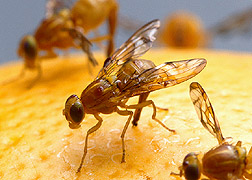This page has been archived and is being provided for reference purposes only. The page is no longer being updated, and therefore, links on the page may be invalid.
|
|
USDA Scientists Develop Alluring Bait for Mexican Fruit FliesBy Tara WeaverNovember 19, 1998 GAINESVILLE, Fla., Nov. 19--Mexican fruit flies, important quarantine pests of citrus and many other crops, are strongly attracted to a new lure developed by scientists based here at the Agricultural Research Service. "The new synthetic lure resembles the pest's natural protein food source," said ARS administrator Floyd P. Horn. "Improved lures and traps for fruit flies can enable action agencies to detect their invasions sooner and act sooner to prevent these pests from spreading." ARS is the U.S. Department of Agriculture's chief scientific agency. Female Mexican fruit flies lay eggs in at least 36 different fruits. In the U.S., the pests could potentially cost $1.4 billion a year in export and crop yield losses and treatment expenses. "Mexican fruit flies periodically cross the Mexican border to infest U.S. fruit orchards, most often in the Lower Rio Grande Valley in Texas," Horn said. Currently, however, USDA and the state of California are cooperating to quell an infestation in San Diego County in California. The new lure has three chemical components: ammonium acetate, putrescine and methyl butanol. ARS chemist Robert R. Heath and entomologist Nancy D. Epsky developed it at the agency's Center for Medical, Agricultural and Veterinary Entomology in Gainesville. ARS has filed for patent protection. In several years of field trials in Guatemala, ARS scientists compared sticky cylindrical traps baited with the new lure and glass McPhail traps baited with liquid protein currently used to detect fruit flies. "The new three-component lure caught almost twice as many insects as the standard lure and was more effective at capturing both males and females," Heath said. Compared to the sticky trap, McPhail traps are fragile and cumbersome, he added. Heath and Epsky have developed several other similar lures. Among them is a different three-component lure containing ammonium acetate, putrescine and trimethylamine. It was recently approved for official use in the Mediterranean fruit fly eradication program in Florida. Scientific contact: Robert R. Heath, Chemistry Research Unit, ARS Center for Medical, Agricultural, and Veterinary Entomology, Gainesville, Fla., phone (352) 374-5735, fax (352) 374-5859, bheath@gainesville.usda.ufl.edu
|

